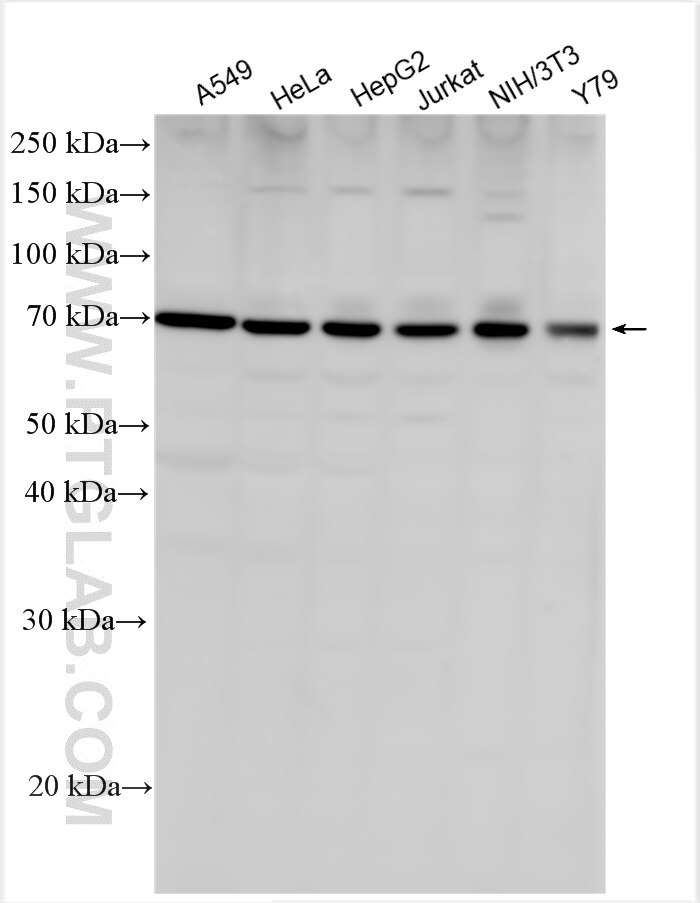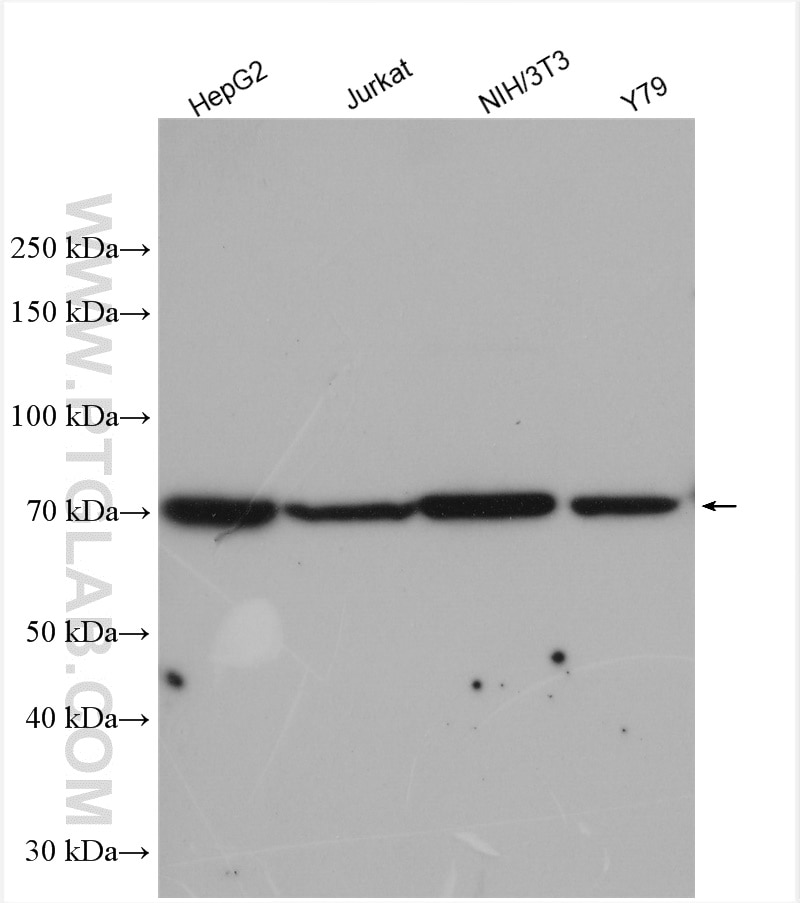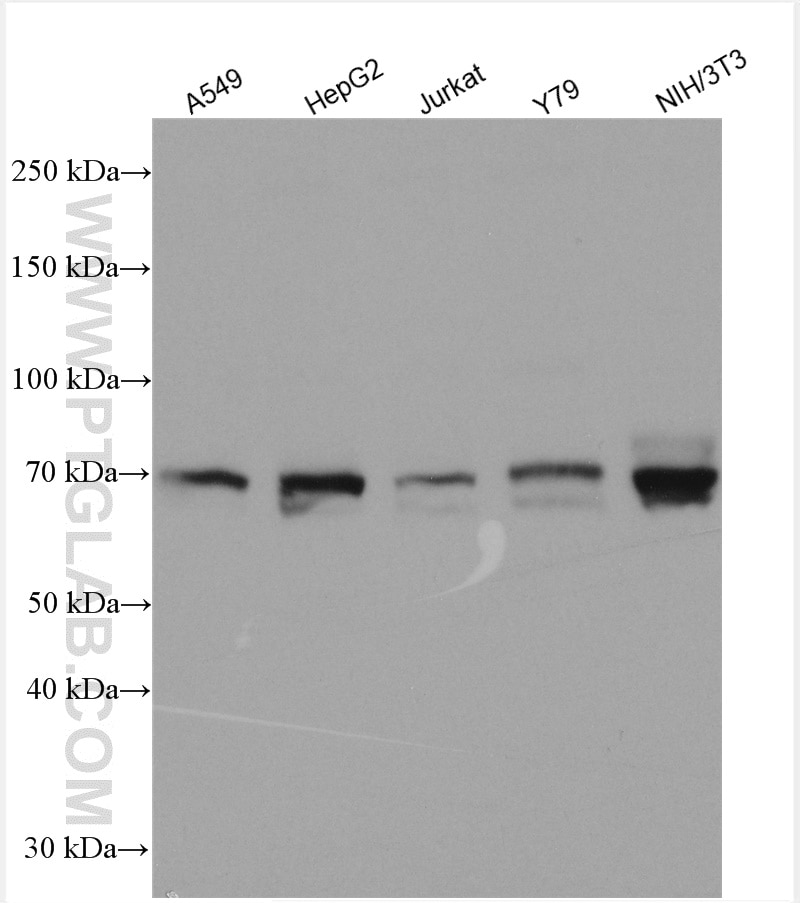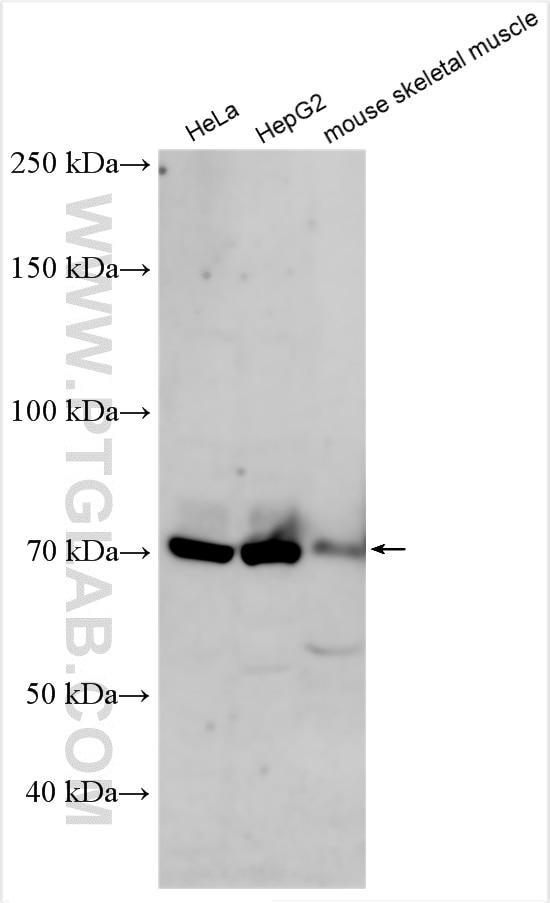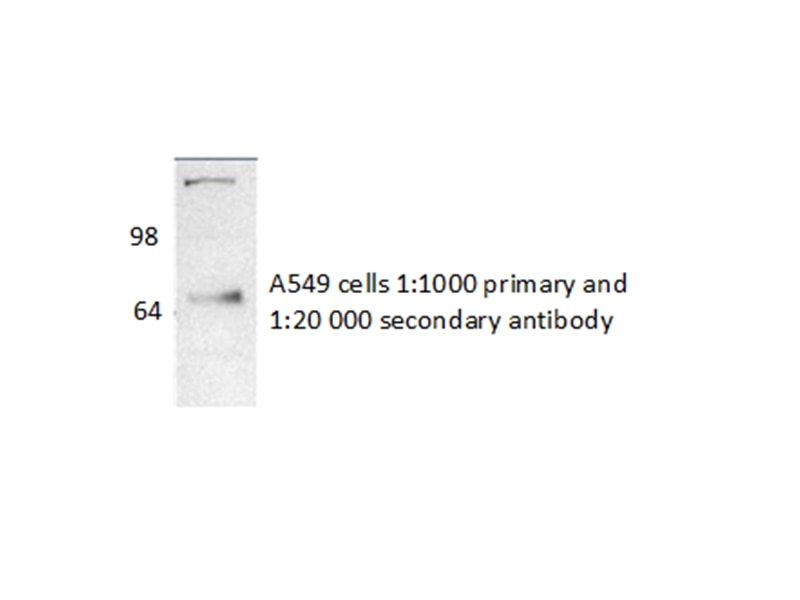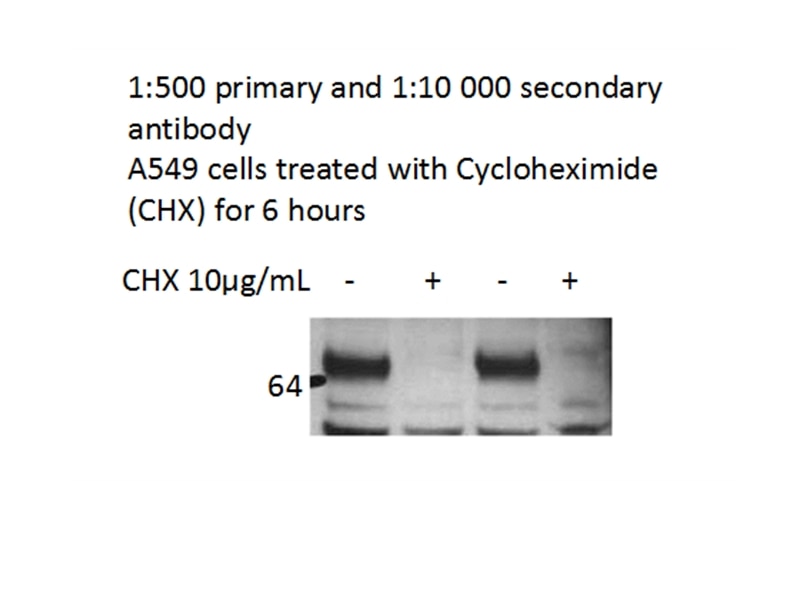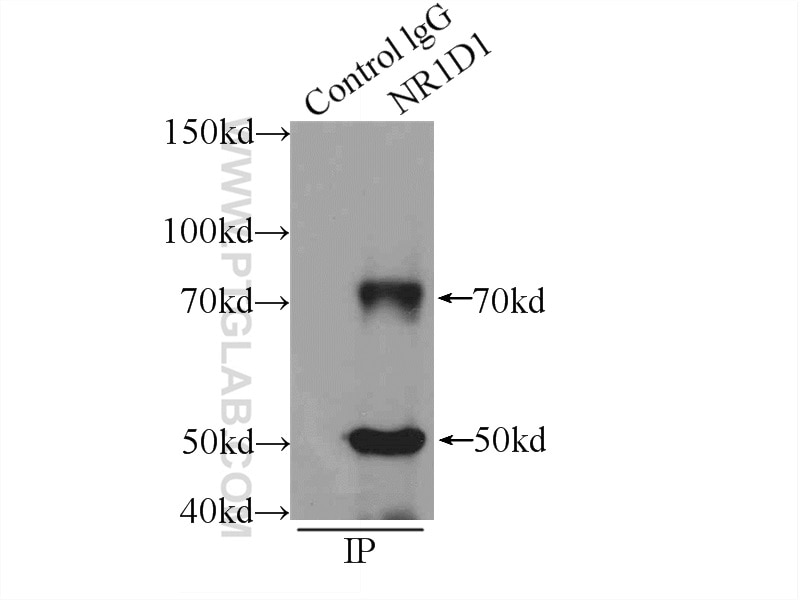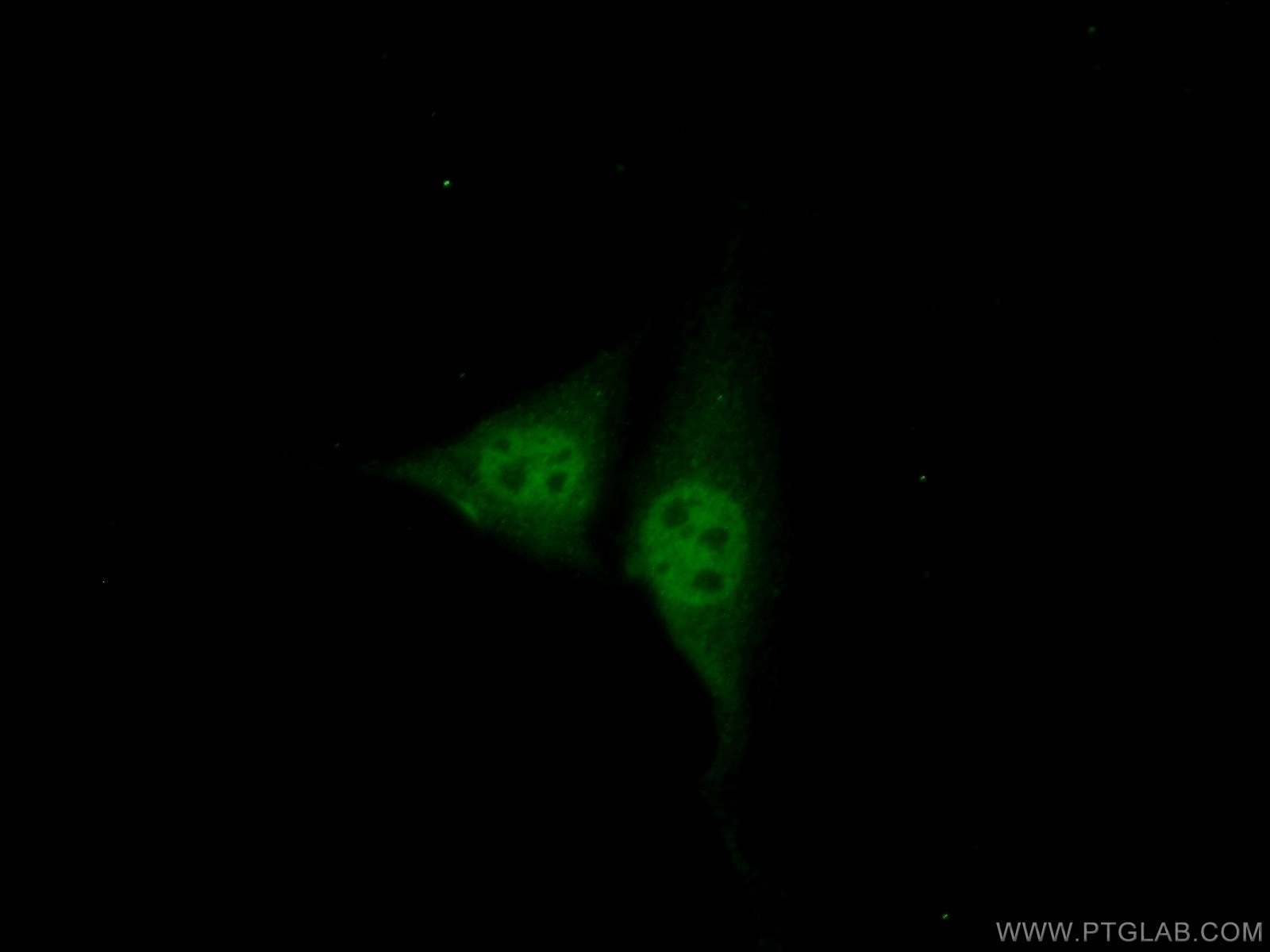- Featured Product
- KD/KO Validated
NR1D1 Polyklonaler Antikörper
NR1D1 Polyklonal Antikörper für IF, IP, WB, ELISA
Wirt / Isotyp
Kaninchen / IgG
Getestete Reaktivität
human, Maus und mehr (1)
Anwendung
WB, IP, IHC, IF, chIP, ELISA
Konjugation
Unkonjugiert
Kat-Nr. : 14506-1-AP
Synonyme
Galerie der Validierungsdaten
Geprüfte Anwendungen
| Erfolgreiche Detektion in WB | A549-Zellen, HeLa-Zellen, HepG2-Zellen, Jurkat-Zellen, Maus-Skelettmuskelgewebe, NIH/3T3-Zellen, Y79-Zellen |
| Erfolgreiche IP | A549-Zellen |
| Erfolgreiche Detektion in IF | NIH/3T3-Zellen |
Empfohlene Verdünnung
| Anwendung | Verdünnung |
|---|---|
| Western Blot (WB) | WB : 1:1000-1:4000 |
| Immunpräzipitation (IP) | IP : 0.5-4.0 ug for 1.0-3.0 mg of total protein lysate |
| Immunfluoreszenz (IF) | IF : 1:50-1:500 |
| It is recommended that this reagent should be titrated in each testing system to obtain optimal results. | |
| Sample-dependent, check data in validation data gallery | |
Veröffentlichte Anwendungen
| KD/KO | See 2 publications below |
| WB | See 18 publications below |
| IHC | See 1 publications below |
| IF | See 3 publications below |
| IP | See 1 publications below |
| ChIP | See 4 publications below |
Produktinformation
14506-1-AP bindet in WB, IP, IHC, IF, chIP, ELISA NR1D1 und zeigt Reaktivität mit human, Maus
| Getestete Reaktivität | human, Maus |
| In Publikationen genannte Reaktivität | human, Maus, Ratte |
| Wirt / Isotyp | Kaninchen / IgG |
| Klonalität | Polyklonal |
| Typ | Antikörper |
| Immunogen | NR1D1 fusion protein Ag5964 |
| Vollständiger Name | nuclear receptor subfamily 1, group D, member 1 |
| Berechnetes Molekulargewicht | 67 kDa |
| Beobachtetes Molekulargewicht | 55-68 kDa |
| GenBank-Zugangsnummer | BC056148 |
| Gene symbol | NR1D1 |
| Gene ID (NCBI) | 9572 |
| Konjugation | Unkonjugiert |
| Form | Liquid |
| Reinigungsmethode | Antigen-Affinitätsreinigung |
| Lagerungspuffer | PBS mit 0.02% Natriumazid und 50% Glycerin pH 7.3. |
| Lagerungsbedingungen | Bei -20°C lagern. Nach dem Versand ein Jahr lang stabil Aliquotieren ist bei -20oC Lagerung nicht notwendig. 20ul Größen enthalten 0,1% BSA. |
Hintergrundinformationen
NR1D1, also named as EAR1, THRAL, ear-1 and hRev, contains one nuclear receptor DNA-binding domain and belongs to the nuclear hormone receptor family. NR1 subfamily. This protein functions as a constitutive transcriptional repressor. It is a possible receptor for triiodothyronine. Rev-erba itself is activated by BMAL1-CLOCK and thereby represents the link between the positive and negative loops of the circadian clock. This is a rabbit polyclonal antibody raised against the N terminus of human NR1D1.
Protokolle
| Produktspezifische Protokolle | |
|---|---|
| WB protocol for NR1D1 antibody 14506-1-AP | Protokoll herunterladen |
| IF protocol for NR1D1 antibody 14506-1-AP | Protokoll herunterladen |
| IP protocol for NR1D1 antibody 14506-1-AP | Protokoll herunterladen |
| Standard-Protokolle | |
|---|---|
| Klicken Sie hier, um unsere Standardprotokolle anzuzeigen |
Publikationen
| Species | Application | Title |
|---|---|---|
Nat Commun The tight junction protein TJP1 regulates the feeding-modulated hepatic circadian clock. | ||
Theranostics PPAR-γ integrates obesity and adipocyte clock through epigenetic regulation of Bmal1. | ||
Cancer Res NR1D1 recruitment to sites of DNA damage inhibits repair and is associated with chemosensitivity of breast cancer. | ||
Cell Death Discov NR1D1 deficiency in the tumor microenvironment promotes lung tumor development by activating the NLRP3 inflammasome | ||
J Neuroinflammation The circadian clock protein Rev-erbα provides neuroprotection and attenuates neuroinflammation against Parkinson's disease via the microglial NLRP3 inflammasome. | ||
Cell Biosci Rev-erbα exacerbates hepatic steatosis in alcoholic liver diseases through regulating autophagy. |
Rezensionen
The reviews below have been submitted by verified Proteintech customers who received an incentive forproviding their feedback.
FH Priya (Verified Customer) (01-17-2023) | I have used for cardiomyocytes, mouse skin and liver tissues
|
FH Satish (Verified Customer) (12-19-2019) | I got clear bands. The antibody detects two band one band around 67 kDa and another band much lower than 67kDa.
|
